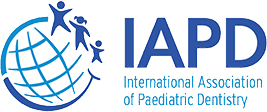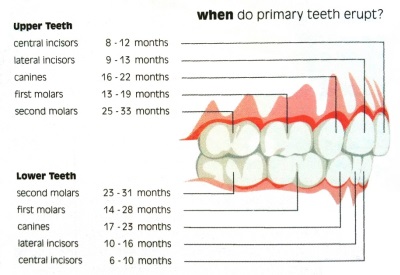
Frequently Asked Questions
The first tooth usually comes in around 6 months of age. Most often it is a lower front tooth. The tooth eruption timing of primary teeth is more variable than for permanent teeth. The front 8 teeth (4 on top and 4 on bottom) usually have come in by 9-12 months of age.
The simple answer is that teeth should be cleaned as soon as the first tooth first appears. Brushing your baby’s teeth with a size appropriate toothbrush and with full strength fluoride toothpaste (1000 ppm) has proven to be the best protection against tooth decay. Children 0-3 years should use a size of a grain of rice of fluoride toothpaste. Training toothpastes offer NO protection against tooth decay.
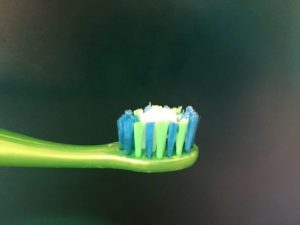
Before teeth erupt, parents can use a clean, small gauze pad or a clean dry wash cloth. The teeth and gums are wiped to remove liquid and food debris. This can be done before bedtime. As soon as the child gets the first tooth, a small, soft toothbrush can be used to clean the all surfaces of the teeth, paying special attention to the grooves on the chewing surfaces of the molars as well as the gums and tongue, using the amount of Fluoride toothpaste shown above. When the child is old enough, parents should teach and encourage spitting out the toothpaste. Rinsing thoroughly is not necessary. Studies show that the best protection against cavities is to brush and spit. Parents should always supervise the toothbrushing routine on young children.
If you are using no more than the size of a grain of rice of Fluoride toothpaste twice a day, it is safe if the baby swallows it. The very small amount has been calculated to be safe even for a 6 month old. However, it is easy to wipe the excess toothpaste away with a clean gauze or towel while you brush your baby’s teeth.
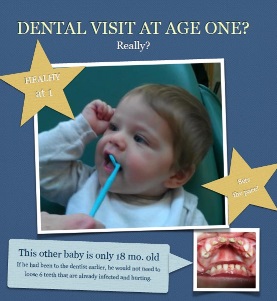
Visiting a dentist when the first tooth erupts or by the first birthday is recommended to help reduce the number of infants and children who suffer from preventable tooth decay.
Why? Seeing the child early gives the dentist the opportunity to examine the mouth and confirm normal oral development. Most importantly, the teeth can be examined for cleanliness. It gives the dentist the opportunity to provide advice on prevention and make the best care plan for your child. It also gives parents the chance to discuss feeding practices, teething and mouth habit. If the child is determined to be at risk of getting cavities, the dentist can apply extra preventive measures like Fluoride varnish. The best plan is to prevent problems from happening rather than to fix problems once they do.
Many babies get cavities soon after their teeth grow into their mouth, as we discuss in question 13. When children are at risk of having cavities, an application of fluoride varnish at the dentist can make their teeth stronger. When you take your child for a dental visit at age 1, and every six months after that, your dentist can evaluate if your child is at risk of having cavities, or already having early signs of having cavities. In that case applying fluoride varnish is an easy, safe and very effective method to protect your baby’s teeth. When children already have the beginning of cavities, applying fluoride varnish every 3 months can prevent the cavities from growing larger, and can even reverse the process. Talk to your dentist about your child’s individual needs for fluoride applications.
For those babies not being breast fed, there is general agreement that around one year of age is a good time to wean baby from the bottle. Pediatric dentists like to see children give up bottles as soon as possible. That is because they see an alarming number of toddlers with Early Childhood Caries. This type of decay, which begins on the front teeth, can result from prolonged use of a milk or sweetened liquid bottle, or when it is put into bed with the baby. Same thing can happen when the baby drinks sweet liquids from a sippy cup.
Weaning from the bottle seems to follow two paths. The first is stopping the bottle suddenly. It is a “cold turkey” approach. The second method is a gradual reduction in the usage of the bottle. Reduction usually begins during the day when baby is able to drink from a cup. The last and most difficult bottle to be discontinued is the bottle before bedtime.
Parents should keep in mind that it is not the bottle or the sippy cup that cause the problem. It is the sweet drinks in them that can cause cavities. If your baby has to suck from a bottle or a sippy cup after the teeth erupt, the best is to put only WATER in them. This approach also helps by creating the healthy habit of drinking water rather than sweet drinks.
Nursing is the natural and healthiest form of nurturing for both mommy and baby. It is recommended as the ideal form of infant nutrition by Pediatricians and the medical community. Before the baby grows teeth, following the schedule recommended by your pediatrician is the best. Once the baby grows the first tooth, start brushing twice a day with the size of a grain of rice of Fluoride toothpaste, and try to minimize night feedings. Mother’s milk has sugars that have the potential to start cavities when left in the mouth for extended periods of time. Babies that have teeth and are nursed at-will through the night, can develop cavities as severe as those produced by a nursing bottle.
Sucking is a basic instinct of infants. Over the years there have been numerous debates as to the usefulness of pacifiers. The benefits attributed to them seem to outweigh any potential shortcomings for children younger than 2. If it helps to comfort your baby then use the pacifier. Be certain to use pacifiers with a large flange that sits on the outside of the mouth and an oval shaped teat. This type of pacifier is recommended for safety and better dental development.
For years many thought that teething caused fever and general sickness. Teething has been blamed for many things! Research into the problems of teething has shown that some children become irritable, have increased drooling and sometimes a facial rash. However, for most children the effect of teething is teeth! It is a normal part of development. If your child has a high temperature that worries you, it is unlikely to be caused by teething and you should consult your physician.
Many remedies have been suggested over the years. There are non-medical things that can help. Teething rings have been found to be helpful for some babies. The biting pressure seems to relieve some discomfort especially if the teething ring is chilled. Another easy alternative is to use a clean, wet towel placed in the freezer that can offer a soft cold surface for the baby to chew. Pain relief tablets and special local anesthetic medicines available for this purpose should be left as a last resort.
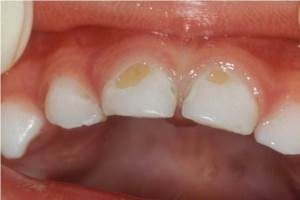

About 1 in 10 children experience tooth decay before they are two years old. In certain communities that number can be much higher. The most common cause is when a baby is placed in the crib at night with a bottle of milk or sweetened liquid. The contents of the bottle cling to the teeth all night. Tooth decay begins! The same effect can occur with a sweetened pacifier. In rare circumstances, babies who are breast fed throughout the night over a long time are also at risk. The decay experienced by these toddlers has a typical pattern. It usually is evident near the gum line of the upper front teeth. Because of the age of these children, treatment becomes a major problem sometimes even requiring general anesthesia. Parents need to be alert and keep the teeth healthy by brushing twice a day with the size of a grain of rice of fluoride toothpaste as soon as the first tooth erupts. Occasionally when illness or some other disturbance affects growing teeth, the quality of the enamel is poor. These teeth can decay early and more easily. A dental examination around one year of age helps identify these problems, and allows your dentist to implement additional preventive measures, like the professional application of fluoride varnish.
Some children grind their teeth at night. It is a habit called bruxism. It is not unusual in the early years, especially in periods when the children are growing new teeth. We know that this really worries parents but it rarely requires treatment.
The grinding habit is usually minor and only in rare occasions it will cause the teeth to wear teeth significantly. Regular visits to the dentist will allow to evaluate the wear and establish preventive measures to limit damage to the teeth.
For years the importance of primary teeth was underrated. Once their importance was recognized, permanent teeth improved. There are the obvious reasons why primary teeth are important – chewing, speaking, and appearance. Primary teeth do more. They conserve the space in the jaws for permanent teeth. If primary teeth are removed ahead of their natural time to fall out, space for the second teeth may be lost. Children who have had caries in their primary teeth have many more chances to have cavities in their permanent teeth. Establishing good habits that prevent tooth decay in primary teeth paves the way to a lifetime with a healthy mouth.
Many children have unfortunate accidents and can damage their mouths and teeth. A wide range of injuries can occur. Sometimes the damage to the primary teeth are of little concern and sometime they are severe and teeth can be moved about or knocked out. The more serious injuries can cause damage to the permanent teeth that are still forming in the jaws. The amount and type of damage depends on the age of the child as this reflects the stage of development of the underlying second tooth. The amount of injury will not be seen until the permanent tooth comes into the mouth. A consultation with the dentist as soon as the injury happens is always recommended as evaluation of the damage (usually with x rays) and necessary measures to limit the problems can be implemented.
